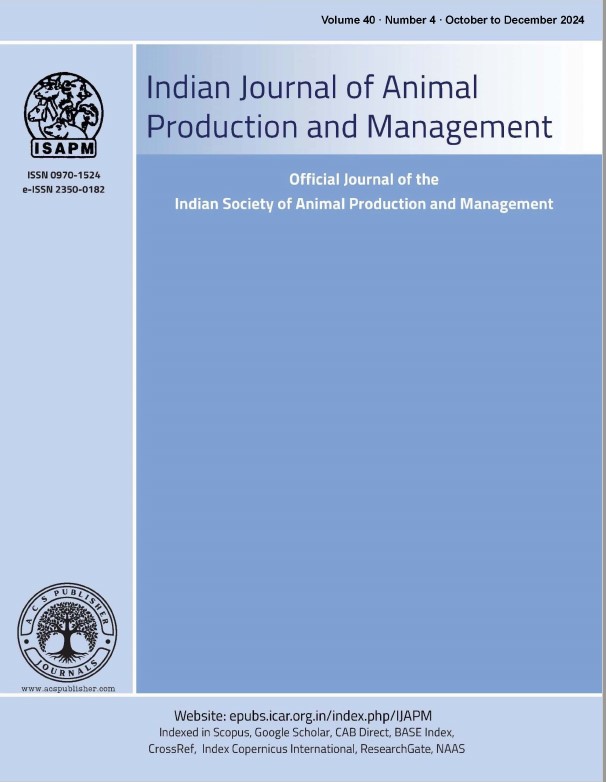A Study on Biometric Parameters and Chemical Composition of Super Napier Green Fodder
DOI:
https://doi.org/10.48165/ijapm.2023.37.4.14Keywords:
Biometric parameters, chemical composition, Super NapierAbstract
An experiment was conducted to study the biometric parameters of Super Napier green fodder along with assessment of chemical composition, cell wall constituents and fodder characteristics at different days of harvest at Livestock Research Station, Siddarampuram, in Anantapur district. The fodder characteristics of Super Napier i.e., plant height (cm), basal circumference (cm), tillers per plant (number), leaves per tiller (number), leaves per plant (number) increased as age advanced showing a significant difference (P < 0.01) at 15, 30, 45 and 60 days of harvesting. The mean proximate values of Super Napier fodder for DM, CP, CF, EE, TA and NFE were 22.43 ± 2.35, 9.94 ± 1.04, 32.66 ± 1.63, 1.94 ± 0.23, 11.32 ± 1.23 and 44.11 ± 1.47 per cent, respectively. The mean cell wall constituents of NDF, ADF, Hemicellulose, Cellulose, ADL and Silica were 63.64 ± 1.51, 37.90 ± 1.54, 25.74 ±1.47, 27.31 ± 1.74, 8.26 ± 1.31 and 3.38 ± 0.28 per cent, respectively. The leaf area index noticed at the time of harvest was 9.43. The leaf to stem ratio observed at 15th, 30th, 45th and 60th day of harvest was 1.50 ± 0.22, 0.65 ± 0.05, 0.43 ± 0.03 and 0.22 ± 0.11, respectively. Highest leaf to stem ratio was recorded at 15 days of age and lowest at 60 days of age.
References
Andrade, A. C., Fonseca, D. M. D., Lopes, R. D. S., Nascimento Júnior, D. D., Cecon, P. R., Queiroz, D. S., & Reis, S. T. 2005. Growth analysis of' Napier elephant grass fertilized and irrigated. Ciência e Agrotecnologia, 29(2): 415-423.
AOAC 1995. Official methods of analysis (16th edition) Association of official Analytical Chemists, Washington DC.
Deresz, F., Paim-Costa, M. L., Coser, A. C., Martins, C. E., & Abreu, J. B. R. D. 2006. Chemical composition, in vitro dry matter digestibility and forage mass of Elephant grass cv. Napier pasture managed in a rotational grazing system. Revista Brasileira de Zootecnia, 35(3):
-869.
Gangaiah, B. and Dinesh kumar 2004. Response of Guinea grass (Panicum maximum Jacq.) to irrigation schedules. Annals of Agricultural Research, 25(4): 495- 497.
Halim, R. A., Shampazuraini, S., & Idris, A. B. 2013. Yield and Nutritive quality of nine Napier grass varieties in Malaysia. Malaysian Journal of Animal Science, 16(2): 37-44.
Jagadamba, K. 2008. Study on cultural practices and chemical evaluation of perennial fodder varieties suitable under low irrigation input conditions (Doctoral dissertation, Sri Venkateswara Veterinary University, Tirupati–517 502, AP).
Jung, H. G., and Allen, M. S. 1995. Characteristics of plant cell walls affecting intake and digestibility of forages by ruminants. Journal of Animal Science, 73(9): 2774-2790.
Lenvill, D. E., Dalor. F., and Hedgas, H. F. 1978. Solar radiation weighing for weather and corn growth models – Agronomy for weather and corn growth models. Agronomy to Tropics, 70(2): 257-263.
Lounglawan, P., Lounglawan, W., & Suksombat, W. 2014. Effect of Cutting Interval and Cutting Height on Yield and Chemical Composition of King Napier Grass (Pennisetum Purpureum x Pennisetum Americanum). APCBEE procedia, 8: 27-31.
Negawo, A. T., Teshome, A., Kumar, A., Hanson, J., & Jones, C. S. 2017. Opportunities for Napier grass (Pennisetum purpureum) improvement using molecular genetics. Agronomy, 7(2): 28.
11. Pal, D. T., and Bujarbaruah, K. M. 2002. Comparative studies on production potential of natural and cultivated grasses and their nutrient utilization in mithun. Indian Journal of Animal Sciences, 72(11):
-1003.
Pitaksinsuk, C. J., Boonjaracha, J., Wongpipat. 2010. Data collection of fodder Nutritive value. Bureau of Animal Nutrition, Department of Livestock Development. 77p.
Premaratne, S., and Premalal, G. G. C. 2006. Hybrid Napier (Pennisetum perpureum x Pennisetum americarnum) var. CO-3: A resourceful fodder grass for dairy development in Sri Lanka. Journal of Agricultural Sciences, 2(1): 22-33.
Shashikanth, V. S., Somashekhar, K. S., Shekara, B. G., & Krishnappa, M. R. 2013. Performance of bajra napier hybrid varieties in southern dry zone of Karnataka for the kharif season of different years. Forage Research, 39(2): 64-66.
Snedecor, G. W. and Cochran, W. G. 1994. Statistical methods. 8th edition.lowa, State University press, Ames, lowa.
Toor, A. K., Kumar, A. and Kapur, R. 2017. Evaluation of Napier Bajra Hybrids for Yield and Other Parameters. International Journal of Genetics, 9(7): 287-290.
Van Soest, P. J., Robertson, J. B. and Lewis, B. A. 1991. Methods for dietary fiber, neutral detergent fiber and non-starch polysaccharides in relation to animal nutrition. Journal of Dairy Science, 74: 3583-3597.
Vennila, C., and Sankaran, V. M. 2017. Influence of nutrients on growth and yield of Bajra Napier hybrid grass. Current Journal of Applied Science and Technology 23(5): 1-6.
Wangchuk, K. Rai, K. Nirola, H. Thukten. Dendup, C and Mongar, D. 2015. Forage growth, yield and quality responses of
Napier hybrid grass cultivars to three cutting intervals in the Himalayan foothills. Tropical grasslands-Forrajes Tropicales, 3: 142-150.
Watson. D. J., 1952. The physiological basis of variation in yield. Advances in Agronomy, 4: 101-145.

